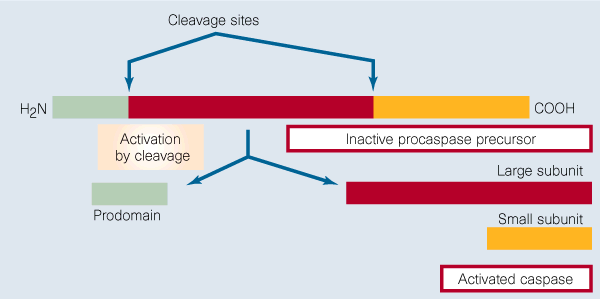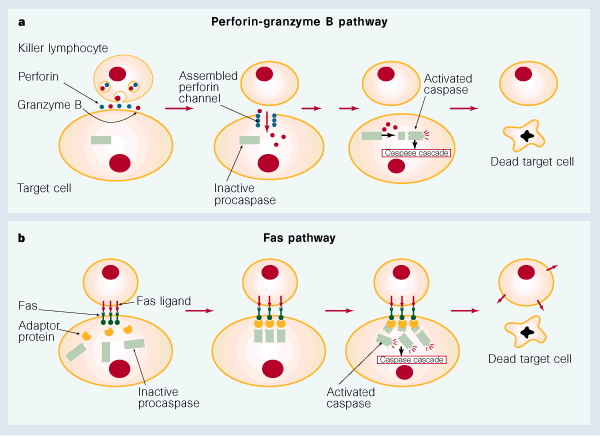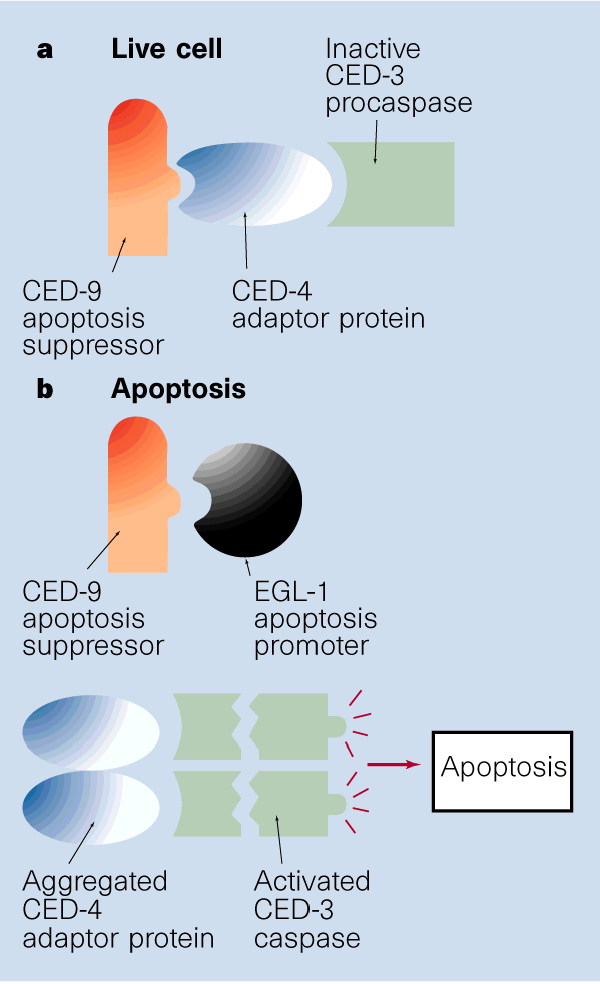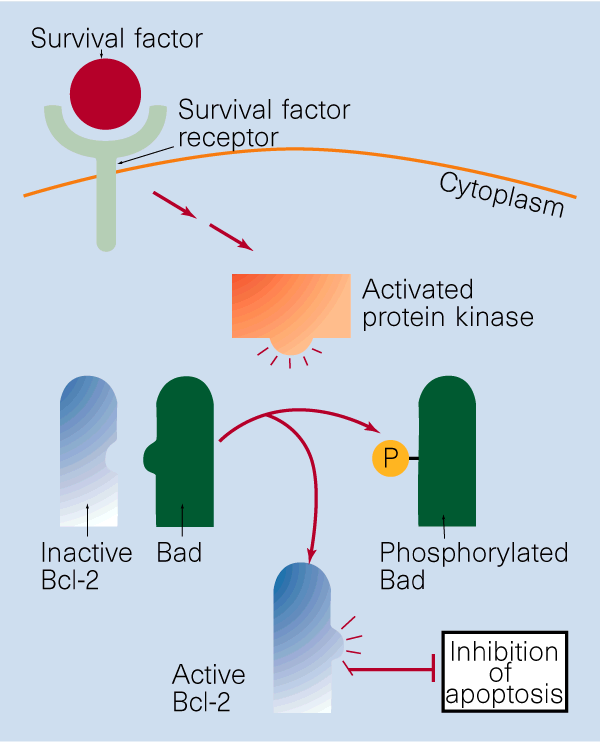Cell suicide for beginners (original) (raw)
The ability to commit suicide is a fundamental property of animal cells. This overview considers recent progress in understanding the nature of the suicide process and how it is controlled.
The ability to commit suicide is a fundamental property of animal cells. This overview considers recent progress in understanding the nature of the suicide process and how it is controlled.
Cell death is an invariable part of animal development, and it often continues into adulthood. In a mature human, for example, millions of cells die every minute; we remain the same size only because, by an unknown mechanism, cell division exactly balances cell death. It seems peculiarly wasteful for so many cells to die, especially as most of them are perfectly healthy at the time of their demise. What purpose does this carnage serve?
In some cases the answer is clear1. During development, cell death helps sculpt parts of the body, carving out cavities or separating digits, for example; it also eliminates structures that once served a function, but are no longer needed, such as the tail of the tadpole when the tadpole becomes a frog. Throughout vertebrate life, cell death eliminates most newly formed lymphocytes (the principal cells of the immune system), including those that are useless or potentially dangerous. It also helps to control cell numbers by removing excess cells: neutrophils (a type of white blood cell), for instance, are produced continuously in the bone marrow, but the vast majority die there within a few days without ever functioning2. This apparently futile cycle of production and destruction presumably serves to maintain a ready supply of cells that can be mobilized to fight infection wherever it occurs in the body. Compared with the life of the organism, cells are apparently cheap.
Based on the characteristic way cells look when they die in different circumstances, it was proposed in 1972 that normal cell deaths, as well as some pathological ones, are suicides3. That is, the cells activate an intracellular death programme and kill themselves in a controlled way — a process now known as programmed cell death, or apoptosis. Apoptotic cells shrink and are rapidly eaten by neighbouring cells, before there is any leakage of their contents. Because they are eaten and digested so quickly, there are usually few dead cells to be seen, even when large numbers of cells have died. This is probably why apoptosis was neglected for so long and why its extent is almost certainly still underestimated. By contrast, cells that die accidentally in response to an acute injury often do so by an uncontrolled process called cell necrosis: they swell and burst, spilling their contents over their neighbours and eliciting a damaging inflammatory response.
The idea that animal cells have a built-in death programme was a crucial insight, but its general acceptance took another 20 years. That came only when studies of the nematode worm Caenorhabditis elegans identified genes dedicated to apoptosis and its control1; then, with the discovery of similar genes with similar functions in humans4,5, the cell death field was radically transformed — from neglect to hysteria in one or two years.
Mechanism
The studies in C. elegans identified two genes, ced-3 and ced-4 (ced for cell death abnormal), required for apoptosis in the worm: if either gene is inactivated by mutation, the 131 cell deaths that normally happen during the development of the worm (which has only about 1,000 cells when mature) fail to occur1. Remarkably, the mutant worms with 131 extra cells have a normal life span, showing that in this organism apoptosis is not essential for either life or normal ageing. By contrast, more complex animals cannot survive without apoptosis: mutations that inhibit apoptosis in the fruitfly Drosophila melanogaster, for example, are lethal early in development6, as are mutations in mice that inhibit apoptosis mainly in the developing brain7.
The protein encoded by the ced-3 gene was found to be very similar to a human protein called interleukin-1-converting enzyme (ICE)4. ICE is an intracellular protein-cleaving enzyme (a protease) that cuts out interleukin-1, a signalling protein that induces inflammation, from a larger precursor protein8. The similarity between the CED-3 and ICE proteins was the first indication that the death programme depends on protein cleavage (proteolysis).
Soon new members of the CED-3/ICE family of proteases were identified, including more than ten in humans, many of which become activated in apoptosis8. They all have the amino acid cysteine in their active site and cleave their target proteins at specific aspartic acids, and so are called caspases9. Each is made as a large, inactive precursor (a procaspase), which is itself activated by cleavage at aspartic acids, usually by another caspase8 (Fig. 1). In apoptosis, caspases are thought to be activated in an amplifying proteolytic cascade, cleaving one another in sequence.
Figure 1: Activation of a caspase.
The protein is made as a large inactive precursor (a procaspase), which is activated by cleavage at two aspartic acids. The ‘prodomain’ is discarded, and the large and small subunits form the active enzyme. It is thought that there are two large and two small subunits in an activated caspase (not shown). The activating cleavages are usually catalysed by caspase or procaspase molecules themselves.
Once activated, some of the caspases cleave other specific proteins in the cell to help kill the cell quickly and neatly8. They cleave proteins supporting the nuclear membrane, for example, thereby helping to dismantle the nucleus; they cleave a protein that normally holds a DNA-degrading enzyme (a DNase) in an inactive form, freeing the DNase to cut up the DNA in the cell's nucleus10; they cleave protein constituents of the cell's skeleton and other proteins involved in the attachment of cells to their neighbours, thereby helping the dying cell to detach and round up, making it easy to ingest; and so on.
One of the earliest changes in apoptosis is the movement of a negatively charged phospholipid molecule (phosphatidylserine) from the inner to the outer surface of the cell membrane, where it helps mark the cell surface so that the dying cell is quickly recognized and eaten by a neighbouring cell11. It is still uncertain how caspase activation leads to this lipid rearrangement.
The caspases required for apoptosis vary depending on the cell type. When the mouse gene encoding caspase-3 is inactivated, for example, normal apoptosis fails to occur in some cells in the developing brain. In consequence, the mouse dies around birth with a deformed brain that contains too many cells; apoptosis occurs normally, however, in most of the other organs of such mice7. The caspases required for apoptosis in the same cell type can also vary depending on the stimulus that induces the process: caspase-9, for instance, is required for some lymphocytes to undergo apoptosis in response to gamma irradiation but not to ultraviolet irradiation12. Some caspases such as ICE (caspase-1) seem not to be directly involved in apoptosis at all, but instead help generate inflammatory signals such as interleukin-18.
Activation
The procaspases and other proteins required to carry out the death programme are made continuously by healthy cells, from the earliest stages of an animal's development. Thus the suicide machinery is always in place; all that is needed is a trigger to activate it13. How, then, is the death programme activated? There are only a few cases where the mechanism is known.
When we become infected by a virus, some lymphocytes become activated and induce the infected cells to kill themselves (thereby preventing the virus from multiplying and spreading to other cells). The lymphocytes secrete various proteins onto the surface of the infected cell: one of them (perforin) assembles into transmembrane channels that allow other proteins to enter the cell; one of these (granzyme B) is a protease that cleaves and activates certain procaspases to begin the proteolytic death cascade14 (Fig. 2a).
Figure 2: Two ways that a lymphocyte can kill a target cell.
In both cases procaspases are activated in the target cell, leading to apoptosis. a, The lymphocyte secretes proteins onto the target cell surface: the perforin protein assembles into channels that enable the granzyme B protein to enter the target cell and activate procaspases. b, Fas ligand on the lymphocyte surface binds to the Fas protein on the target cell, causing the Fas molecules to form clusters. An adaptor protein then binds to the clustered Fas molecules and recruits inactive procaspase-8 molecules, which then activate one another to initiate the caspase cascade.
Killer lymphocytes have a second way of inducing cells to kill themselves. They produce a protein (Fas ligand) that binds to receptors (Fas) on the surface of the target cell, causing the receptors to aggregate15. The aggregated receptors recruit adaptor proteins from the cytoplasm, which, in turn, recruit procaspase-8 molecules into the aggregate; the clustered procaspase molecules cleave and activate each other to begin the suicide sequence16 (Fig. 2b). This killing mechanism is used, for example, to eliminate normal activated lymphocytes after they have done their job, which helps to terminate immune responses15. Remarkably, stressed cells sometimes insert both Fas and Fas ligand into their surface membrane, and use them to activate procaspases and kill themselves.
Procaspases can also become activated without a stimulating signal at the cell surface, especially if a cell is stressed or damaged. A cell can somehow recognize when one of its parts is damaged and, if the damage is severe enough, it will activate procaspases from within the cell and kill itself. In one case, the mechanism concerned has been uncovered. When mitochondria are damaged, say by a toxic drug, they can release the protein cytochrome c. This protein normally functions in the electron-transport processes in mitochondria that generate most of the cell's ATP, the main energy carrier in cells. Once it is in the cytoplasm, however, cytochrome c has an entirely different function. It binds to an adaptor molecule similar to the CED-4 protein required for apoptosis in C. elegans. The formation of this complex leads directly to the activation of procaspase-9, which initiates a caspase cascade, leading to apoptosis17 (Fig. 3).
Figure 3: How the release of cytochrome c from mitochondria contributes to apoptosis.
The released cytochrome c molecules bind to CED-4-like adaptor proteins. The adaptor proteins then aggregate and bind procaspase-9 molecules. The clustered procaspase-9 molecules activate one another, and the activated caspase-9 molecules then activate other procaspases, leading to apoptosis.
Surprisingly, cytochrome c also escapes from mitochondria and activates procaspase-9 in this way in many other cases of apoptosis, whether the apoptosis is triggered from outside or inside the cell18. Although the mechanism of escape is uncertain, the released cytochrome c amplifies the caspase cascade, increasing the speed and efficiency of the death process.
Procaspases can also become activated when other parts of the cell are stressed or damaged, but the mechanisms involved are less well understood. Damaged DNA in the nucleus, for example, can activate apoptosis, as can the accumulation of misfolded proteins in the endoplasmic reticulum, where many lipids and proteins are made. One mechanism that triggers apoptosis when DNA is damaged depends on an intensely studied cancer-suppressing protein called p53, which accumulates and becomes activated in response to DNA damage; by various routes, the p53 can either stop cell division or induce apoptosis19. The gene encoding p53 is inactivated by mutation in over 50% of human cancers, which allows the cancer cells to survive and proliferate even when their DNA is damaged; in this way the cancer cells accumulate more mutations that increase their malignancy.
Intracellular controls
A decision to die should not be taken lightly, and so it is not surprising that the death programme is regulated in complex ways, both from inside and outside the cell. A major class of intracellular regulators is the Bcl-2 family of proteins, which, like the caspase family, has been conserved in evolution from worms to humans20. The ced-9 gene in C. elegans encodes such a protein: if it is inactivated, most of the cells in the developing worm die, and the worm therefore dies early in development; but, if ced-3 or ced-4 are also inactivated so that apoptosis cannot occur, the worm and all of its cells live5. So it seems that the only reason any cells in the developing worm live is that ced-9 normally keeps the death programme suppressed in these cells.
The ced-9 gene is similar to the human bcl-2 gene, which was initially identified in a common form of lymphocyte cancer, where a chromosome abnormality causes excessive production of the Bcl-2 protein. The high levels of Bcl-2 promote cancer by inhibiting apoptosis, thereby prolonging cell survival. Remarkably, the human bcl-2 gene is so similar to ced-9 that it can suppress apoptosis in C. elegans when artificially introduced into the worm21.
Fifteen Bcl-2 family members have been identified so far in mammals. Some, such as Bcl-2 and Bcl-X, suppress apoptosis; others, such as Bax, Bad and Bid, promote it20. Some of these proteins can bind to each other; when an apoptosis-suppressor forms a complex with an apoptosis-promoter, each protein inhibits the other's function. The ratio of suppressors to promoters helps determine a cell's susceptibility to apoptosis22.
The Bcl-2 family proteins regulate apoptosis in several ways20,22. Some act simply by binding to and inhibiting apoptosis-suppressors: in C. elegans, for example, such a protein is required to block the inhibitory effects of the CED-9 protein and allow apoptosis to occur in the 131 cells that normally die23 (Fig. 4). Other family members, however, act in more sophisticated ways. CED-9, for example, acts as an apoptosis-suppressor in worms in two ways: it binds directly to the CED-3 caspase, blocking its activity, and it binds to CED-4, blocking its ability to activate the CED-3 procaspase24 (Fig. 4).
Figure 4: How Bcl-2 family proteins are thought to determine whether a cell lives or dies in C.elegans.
a, In cells that live, the CED-9 protein inhibits the CED-4 protein from aggregating and activating the CED-3 procaspase. b, In cells that die, an apoptosis-promoter of the Bcl-2 family (EGL-1) binds to CED-9, thereby releasing the complex of CED-4 and CED-3. The CED-4 can now aggregate, which brings the bound CED-3 procaspase molecules close enough together so that they can activate each other. The complexes are probably bound to intracellular membranes by CED-9.
None of the known mammalian Bcl-2 family apoptosis-suppressors binds directly to caspases, however, although they can inhibit caspase activation indirectly20. Some bind to the CED-4-like adaptor protein and block its ability to activate procaspase-9; some inhibit the release of cytochrome c from mitochondria; and some bind to the apoptosis-promoters and inhibit their function.
Many proteins of the Bcl-2 family have a hydrophobic tail that enables them to bind to the outside surface of mitochondria, the endoplasmic reticulum and the nucleus, and they are thought to function mainly on these organelles. Bax, for example, acts as an apoptosis-promoter, in part at least, by binding to mitochondria, where it can interfere with mitochondrial function and release cytochrome c 18.
The activity of Bcl-2 family members can be regulated by an increase or decrease in the expression of the gene that encodes them or by modification of the proteins themselves, by either the addition of phosphate (phosphorylation) or cleavage by proteases. The cleavage of Bcl-2 by caspases, for instance, inactivates Bcl-2's inhibitory function, while the cleavage of the apoptosis-promoter Bid by caspases releases a fragment that triggers the release of cytochrome c from mitochondria; both events accelerate the death process25,26.
Another important family of intracellular apoptosis regulators are the IAP (inhibitors of apoptosis) proteins. Some of these bind to caspases or procaspases and inhibit them directly. If one of the two known IAP genes in Drosophila is inactivated by mutation, all of the cells in the fly embryo undergo apoptosis (H. Steller, personal communication).
Extracellular controls
Like most functions of animal cells, the death programme is regulated by signals from other cells, which can either activate it or suppress it. These cell-cell interactions are part of the complex ‘social’ controls that ensure that individual cells behave for the good of the animal as a whole — in this case, by surviving when they are needed and by killing themselves when they are not. For the vast majority of normal cells that undergo apoptosis, however, we know little about the signals that tilt the balance towards death. But there are exceptions.
A classic example is the apoptosis that causes the tadpole's tail to disappear at metamorphosis, which is triggered by a surge of thyroid hormone in the bloodstream. In other cases, certain developing cells produce signals that cause only neighbouring cells to die; this seems to be the way that cells are eliminated between developing fingers and toes. The challenge in the latter cases is to understand how these localized apoptosis-inducing signals are produced at precisely the right place and time.
Other normal cell deaths occur because the cells fail to receive enough apoptosis-suppressing signals (also called survival factors) from other cells. Most of our cells seem to require such signals: if a cell is experimentally isolated from its neighbours, it will undergo apoptosis unless it is supplied with the appropriate survival factors. Apparently, the only thing our cells can do on their own is kill themselves, and the only reason they normally remain alive is that other cells are constantly stimulating them to live. This surprising arrangement is thought to ensure that cells normally only survive when and where they are needed27.
Dependence on survival factors also provides a simple strategy for regulating cell numbers. During vertebrate development, for example, more nerve cells are produced than are needed, and they compete for the limited amounts of survival factors produced by the target cells that they normally connect with. Only some of the nerve cells get enough factor to survive; the rest undergo apoptosis, thereby automatically matching their numbers to the number of target cells28.
How do extracellular survival factors, which generally bind to cell-surface receptor proteins, suppress apoptosis? In some cases they activate the production of an apoptosis-suppressor such as Bcl-2 or Bcl-X. In others they block an apoptosis-promoter such as Bad, by activating enzymes (protein kinases) that phosphorylate the protein: unphosphorylated Bad binds and inhibits the apoptosis-suppressing proteins Bcl-2 and Bcl-X, but, when phosphorylated, it releases these proteins so that they can suppress apoptosis29 (Fig. 5). In most cases, however, the mechanism is unknown.
Figure 5: One way that extracellular survival factors can suppress apoptosis.
The survival factor binds to a cell-surface receptor protein, thereby activating various intracellular signalling pathways. Some of these pathways lead to the activation of protein kinases that phosphorylate the Bad protein. Bad promotes apoptosis by binding to and inactivating apoptosis-inhibitor proteins such as Bcl-2. Once phosphorylated, Bad releases its bound Bcl-2 protein, which can now act to inhibit apoptosis. Thus, the survival factor suppresses apoptosis by keeping Bad phosphorylated and out of action.
Cell suicide in non-animal cells
Programmed cell death also occurs in plants — during development, in the senescence of flowers and leaves, and in the response to injury and infection. It is still uncertain whether caspases are involved in any of these cell deaths. Even some unicellular organisms can die in a way that looks like apoptosis, but the molecular mechanisms are not known.
The best understood example of non-animal cell suicide occurs in bacteria. Some strains of Escherichia coli produce an inactive form of a protease. If they become infected by a particular virus, one of the viral proteins binds to the protease and activates it. The activated protease cleaves and inactivates a bacterial protein required for protein synthesis, shutting down synthesis and killing the bacterium — thereby curtailing viral multiplication and protecting nearby E. coli from infection30. Although this bacterial death programme shares a number of features with caspase-dependent apoptosis in animal cells, the proteases involved in the two programmes are unrelated. Other cell suicide programmes in unicellular organisms, however, may have provided the starting point for the evolution of the caspase-dependent programme in animal cells.
Cell death in disease
There are many disorders where cells die prematurely: heart cells die in a heart attack, for example, and brain cells in a stroke. In these acute conditions, many cells die by necrosis. But some of the less badly damaged ones die by apoptosis, and the search is on for drugs that block the process in the hope that some of the apoptotic cell deaths can be prevented.
Many viruses have evolved strategies for blocking apoptosis, so as to prevent infected cells from committing suicide before the virus has had a chance to multiply. Some viruses produce proteins that bind to caspases and block their activity. Although these can be used experimentally to inhibit caspases, they are too large to enter cells, and one has either to inject them into the cell or to introduce the genes that encode them. A more convenient strategy is to synthesize modified small peptides that can enter cells and block the active site of caspases8. Such inhibitors are now widely used by cell biologists: they not only block most forms of apoptosis in cultured cells, but also some forms of apoptosis in experimental animals. Whether they will be useful in human disease remains to be seen.
In neurodegenerative diseases, such as Parkinson's and Alzheimer's, where nerve-cell loss occurs slowly, it is still unclear if the diseased cells die by apoptosis and, if they do, whether it would be helpful to keep them alive. The finding that a viral caspase inhibitor can prevent the loss of nerve cells in the retina and maintain vision in a retinal degenerative condition in Drosophila provides grounds for hope31, especially as the fly disease closely resembles a common genetic condition (retinitis pigmentosa) in humans that causes progressive blindness. The same caspase inhibitor, however, fails to prevent nerve-cell death in a fly model of Huntington's disease32.
In cancer the goal is the opposite. One wants drugs that will activate apoptosis in tumours. Fortuitously, most of the cell-killing anti-cancer drugs used today work at least partly in this way. Unfortunately, they also affect some normal cells, which is why they can have such severe side effects. The challenge remains to find ways to kill cancer cells specifically.
The death programme is often regulated abnormally in cancer cells: for instance, Bcl-2 or other apoptosis inhibitors may be increased, or the p53 gene may be inactivated by mutation. The death programme itself, however, never seems to be completely inactivated in cancer cells, which is both encouraging and surprising. It is surprising because cancer cells evolve by a process of random mutation and selection, so that they become progressively more malignant as they accumulate mutations that improve their ability to survive and proliferate. Mutations that inactivate apoptosis should therefore be advantageous to cancer cells, making it a mystery why the death programme always seems to be present. Perhaps it has too many lethal parts to be inactivated completely.
Questions
Despite impressive recent progress in understanding apoptosis, many mysteries remain. How do cells integrate apoptosis-promoting and apoptosis-suppressing signals to decide whether to live or die? How is the balance between cell division and apoptosis maintained in adult organs? Do animal cells also have caspase-independent suicide programmes? The crucial practical question is whether apoptosis-blockers will be useful in the treatment of human diseases. For conditions like heart attacks and strokes, where cell death is confined to hours or days, I am optimistic.




